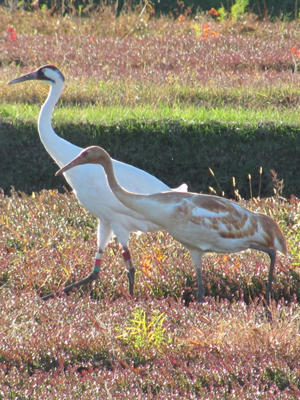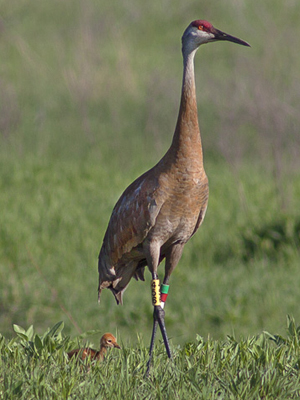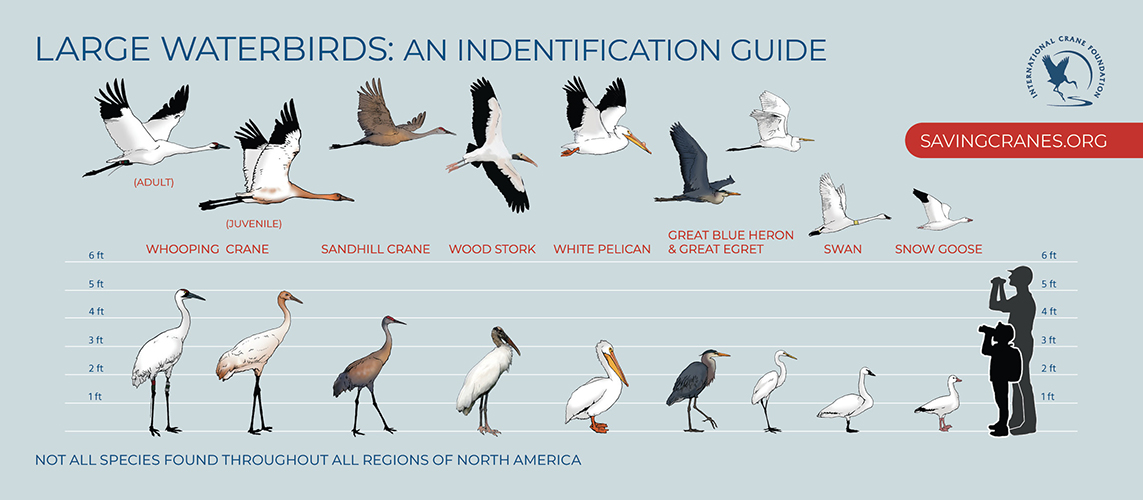Report a Banded Crane

Have you ever seen a crane with “jewelry” on its legs? These colorful bands, or rings, are used by researchers to mark and identify cranes. Many researchers across North America – and the world – band cranes to help answer questions about migration, habitat selection, and other topics.
If you see a banded crane, we want to hear about it! Banded crane sightings are invaluable to researchers, who may never see a bird again after it is banded. Follow the links below to report your sighting of a banded Sandhill or Whooping Crane in North America.
If you see a banded crane outside of North America, please email us and we will forward your sighting to the researchers who banded the bird.

How to Identify a Whooping Crane
With the exception of black wing tips (primary feathers) and a black mustache, the body plumage is snow white. Red skin and sparse, black hair-like feathers cover the bird’s crown. The eye color is golden yellow while the bill is yellowish and sometimes tipped with dull green. Visible portions of the legs and toes are black. Juveniles have entirely feathered heads. Juvenile plumage, except for primaries, is whitish and heavily mottled with cinnamon feathers that diminish as the chick ages. The primaries are dullish black.
If you encounter a Whooping Crane – or any crane – in the wild, please give them the respect and distance they need. Please do not approach birds on foot within 200 yards. If you are in a vehicle, remain in your vehicle and do not approach any closer than 100 yards. Also, please remain concealed and do not speak loudly enough that the birds can hear you. Finally, do not trespass on private property in an attempt to view or photograph cranes.
Report a Whooping Crane
How to Identify a Sandhill Crane
The different subspecies of Sandhill Crane vary greatly in height and weight. Lesser Sandhills, who breed at more northern latitudes such as the Arctic, are the smallest, weighing on average about 6 to 7 pounds and standing 3 to 3.5 feet tall. At the other end of the extreme, temperate-nesting Greater Sandhill Cranes are the largest subspecies and average 10 to 14 pounds and 4.5 to 5 feet tall.
The body plumage is characterized by varying shades of gray. In many areas, wild Sandhill Cranes preen iron-rich mud into their feathers, creating a deep rusty brown color that lasts during spring and summer. As fall advances, these rusty feathers molt and the birds return to their grayish appearance. In some regions, however, iron-rich mud is absent and the birds appear gray all year.
The forehead and crown are covered with reddish skin. The face, chin, upper throat and the back of the neck (nape) are white to pale gray. Adults have a white cheek patch. The legs and toes are black. In general, males and females are virtually indistinguishable, but within a breeding pair, males tend to be larger than females.
View examples of banding protocols for Sandhill Cranes in the eastern United States.
Report a banded Sandhill CraneBirds Similar to Cranes
Still not sure which species you observed? There are several birds in North America that resemble cranes and are often mistaken for a crane at first glance (even by biologists!) If you are unsure about what species you are observing, click here for images and descriptions of some birds that are commonly mistaken for cranes.
